How to Select the Right Holistic Dog Food
1/10/18
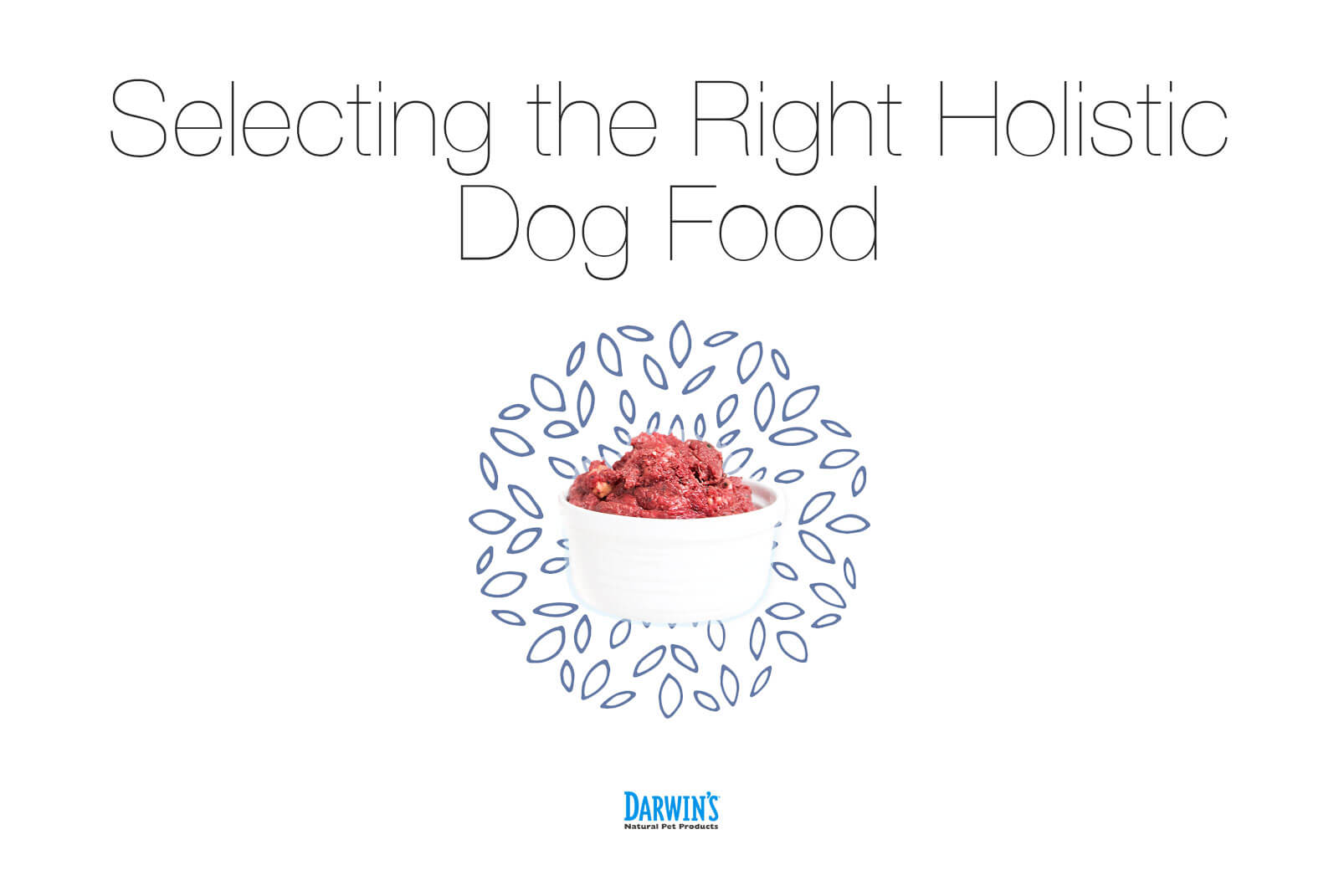
Inside This Article
- What Is Holistic Dog Food?
- Reading and Understanding Dog Food Labels
- Natural, Organic, Grain Free, and Holistic Dog Food
- Benefits of Holistic Dog Food
- Comparing Brands
Is ‘Holistic Dog Food’ a Real Thing?
Increasingly, health-conscious humans are exploring holistic food for themselves, and, naturally, want to provide the same type of wholesome food for their dogs. But what exactly is holistic dog food? The term is often heard, but what does it mean?
This article will help clear up the confusion with the help of two holistic veterinarians: Dr. Tiffany Margolin and Dr. Michael Dym. We’ll also explore the benefits of holistic dog food, what to look for on food labels, a chart to help you tell the difference between natural, organic, holistic, and grain-free dog food, and a comparison of top holistic dog food brands.
What Is Holistic Dog Food?
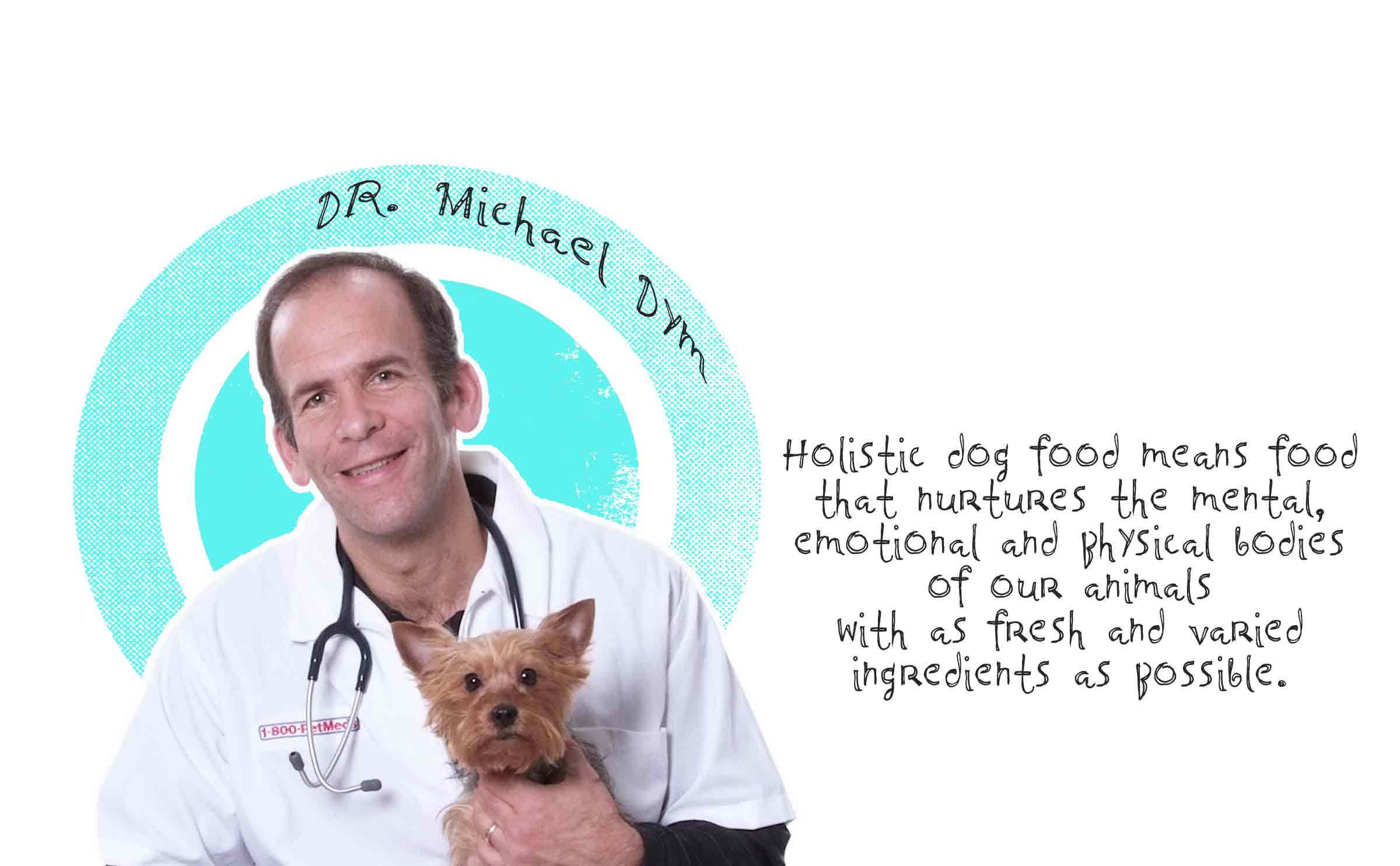
Dr. Michael Dym, VMD has a holistically oriented practice providing natural treatments including homeopathy, vaccine alternatives, and nutritional and dietary therapy at his Florida clinic. According to Dr. Dym, “Holistic dog food means food that nurtures the mental, emotional, and physical bodies of our animals with as fresh and varied ingredients as possible. This means the foods are minimally processed, which is in contrast to most commercial dog foods that leach out many critical ingredients, include cheap protein sources, and use toxic preservatives to increase shelf life.”
Is There a Legal Definition of “Holistic” in the Pet Food Industry?
While the term is widely used, there’s no strict legal definition of holistic in pet foods. “Unfortunately, in the modern era, the term holistic dog food is a catch-all phrase that has been exploited by increasingly large numbers of corporate-owned pet food companies. It’s led to an ever-increasing sea of confusing choices for the animal guardian and consumer,” explains Dr. Dym.
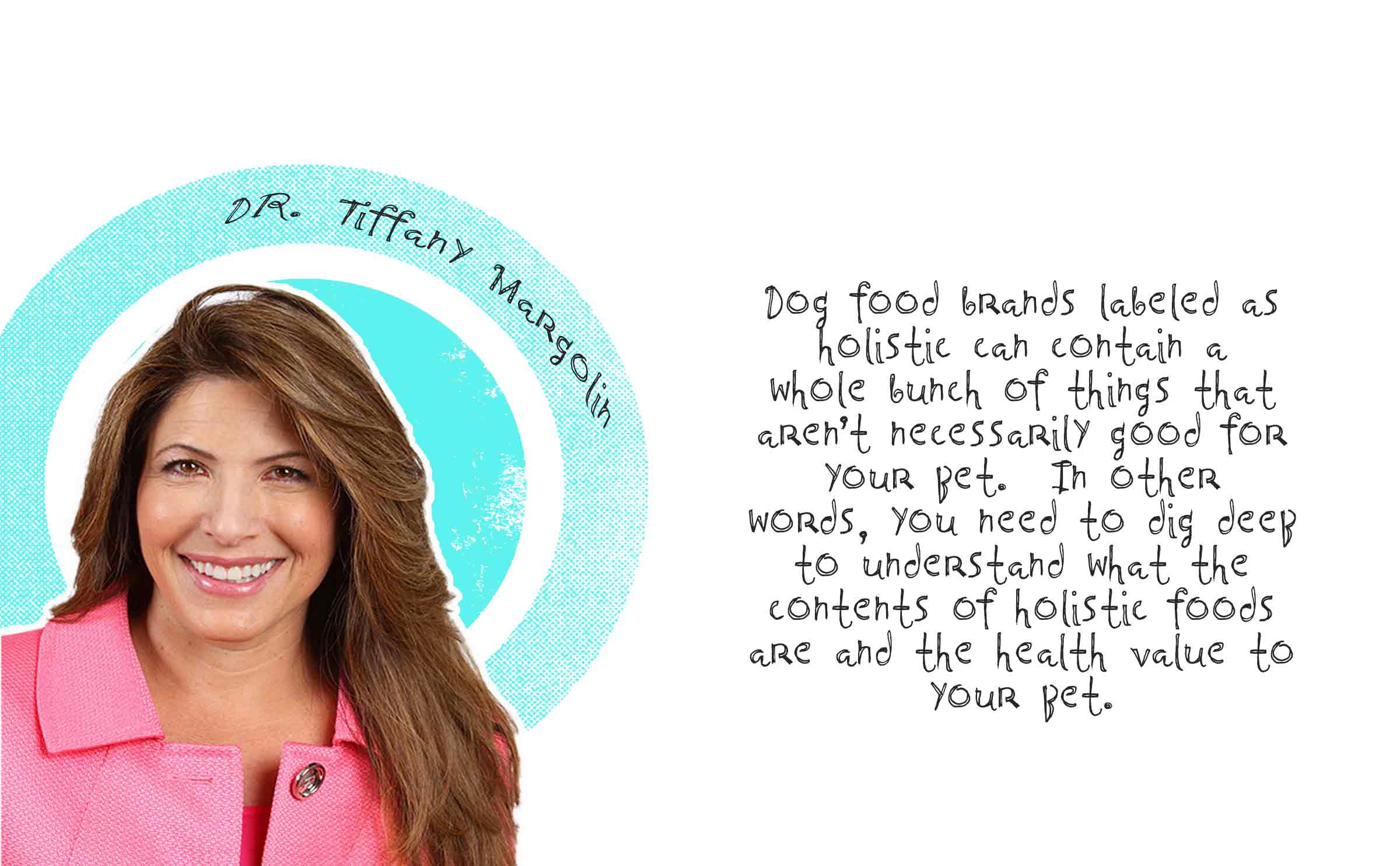
Dr. Tiffany Margolin DVM, CVA is a practicing veterinarian specializing in exotic pets and provides a mobile vet service called From the Heart in Southern California. Based on her experience as a holistic vet for over 25 years, she offers her viewpoint on holistic pet food. “The term holistic doesn’t carry enough information. Dog food brands labeled as holistic can contain a whole bunch of things that aren’t necessarily good for your pet.” In other words, you need to dig deep to understand the contents of holistic foods and the health value to your pet.
Dog Food and Regulatory Standards
Can consumers look to regulatory entities to ensure the quality of dog food? There are a few options available that can help. Here are the facts and links to relevant government agencies for further exploration:
- The U.S. Food & Drug Administration (FDA): The Federal Food and Cosmetic Act is the law that covers pet food. It specifies that pet food sold to the public is safe, is produced to sanitary standards, contains no substances that could harm companion animals, and is labeled honestly. However, there are no pre-market approvals required for manufacturers, and the FDA works with the Department of Agriculture to regulate pet food. Here are links to the FDA Regulation of Pet Food and Information on Marketing a Pet Food Product
- Rendered Meats in Pet Food: The use of 3D and 4D meats (dead, diseased, dying, or destroyed) are allowed as pet food ingredients. The FDA states:
Rendered animal feed ingredients include the various poultry, meat, and marine products which result from the rendering of these animal tissues. Rendering of poultry and other animal tissues has been practiced for over a hundred years as a means of salvaging valuable protein and fat content from otherwise waste material. For many years’ end products from rendering have been used to feed animals. The rendering industry utilizes packinghouse offal, meat processing waste, restaurant waste and animal tissues from other sources including animals that have died otherwise than by slaughter.
- The U.S. Department of Agriculture (USDA): The USDA has no regulatory authority over pet food and only regulates meat and other food for human consumption. USDA’s pet food certification program is voluntary and not recognized by the FDA or USDA. Once meat becomes ‘a pet food’ it’s no longer the responsibility of the USDA. The APHIS (Animal Plant Health Inspection Services) division of the USDA has minor oversight of pet food intended for export outside the U.S.
- The Association of American Feed Control Officials (AAFCO): AAFCO has no regulatory authority over pet food, nor have they established definitions for ‘natural,’ ‘organic’ or ‘holistic’ pet foods. AAFCO is a non-governmental organization that has FDA and State Department of Agriculture members. Members act as advisors and write Model Bills, which may or may not be accepted by states. AAFCO has established the nutritional requirements of dog and cat food, legal definitions of all pet food/animal feed ingredients, and labeling requirements. But the organization doesn’t make access to the information very easy: AAFCO’s Pet Food Labeling Guide is only available through online ordering at a cost of $100 for members and $200 for non-members.
Reading and Understanding Dog Food Labels
Understanding how to read pet food labels is the first step to feeding your dog exactly what you intend to give them—you can’t trust the front of the package because the real truth lies on the flip side.
Dr. Dym notes that dog food labels list ingredients by weight in descending order. Usually, the first through seventh ingredients are the main components. You should look for wholesome ingredients in that section of the label and avoid foods that include partial grains, by-products, and unnamed meat meals in the top ingredients. Grains can cause allergies in a dog, while by-products typically consist of non-meat material extracted from slaughtered mammals that are deemed unsuitable for human consumption. Dr. Dym also advises that while “meat meal” may sound wholesome, it includes meat from any source, including 3 and 4-D animals.
The ‘No” List: What You Don’t Feed Is as Important as What You Do Feed
Many of us humans are becoming steadily more aware of the harm that chemical and preservatives in our food can cause. The same holds true for our pets, and it makes sense to avoid specific ingredients in your pets’ food that should be avoided in human food. If you want to provide the cleanest possible diet for your dog, you may need to just say no to many different types of additives that are commonly found in pet food:
- No Antibiotics: Humans and pets need to limit their exposure to antibiotics because superbugs are being created that are hard to treat. Antibiotics also kill the good bacteria that produce hormones and vitamins and elbow out harmful bacteria. Killing off good bacteria can make your pet vulnerable to chronic bowel and skin conditions caused by yeast overgrowth and damage the immune system.
- No Grains: Dogs evolved primarily as meat eaters. Although now “domesticated,” our pet’s digestive tracts and pancreas’ are not efficient in utilizing plant material as a source of high-quality protein. Why is grain an ingredient in dog food at all? They are cheap fillers.
- No Artificial Preservatives: Dym says that artificial preservatives are known to, or are suspected to, cause cancer in humans, and it’s likely that they do the same in our smaller canine companions, although they tend to be added in the same amounts as in human foods. “Examples of preservatives that should be avoided include nitrate, sodium nitrate, BHA, BHT, and ethoxyquin. So far, studies of chronic preservative intake are inadequate for us to understand the consequences—but avoidance may be the best course of action,” explains Dr. Dym. Natural preservatives are made from Vitamins C or E.
- No Dyes: Artificial food dyes are proven sources of health problems in humans, and every year more of them are deemed unsafe and removed from the market. Their purpose is to look more appealing to humans – so why are they in dog food? For the same reason: to make pet food more appealing to human eyes. They are an unnecessary and likely harmful addition to pet foods that should be avoided.
- No Hormones: Hormones are in dog food because it has been used in the livestock feed given to cattle, birds, or dairy products that end up in your pet’s food bowl. Hormones are usually given to make animals grow larger, for cows to produce more milk, and grow faster so they can be brought to market more quickly. Additional hormones in human and animal food can cause reproductive problems in pets, early puberty, and weight issues.
- No Pesticides: Chemical or biological agents that protect crops from infections, weeds, and insects may sound like a good thing. However, they have been found to cause diarrhea, confusion, anxiety, and nausea at low levels. At high levels, these agents can be associated with more severe problems like neurological disorders, skin conditions, respiratory and reproductive problems in humans, and many animal experts extend those to pets.
- No Fillers or By-Products: Fillers and by-products are only beneficial because they save money and make money— for commercial pet food companies. You definitely don’t want these ingredients in your dog’s food:
What Are Fillers? Fillers add no nutritional value. They add bulk or fiber and weight, but not much else, to commercial dog food. Dogs do require some dietary fiber, but according to Dr. Dym, “Whole grains and vegetables are a preferred fiber source. Avoid rice bran, wheat mill run, pulps, and hulls. At the very least, they should not be in the main list of ingredients.” Dr. Dym also wants to make pet food consumers aware of an additional type of filler: plant-based protein boosters. “These fillers, such as soybean meal, corn, corn germ meal and corn gluten should be avoided,” says Dr. Dym “They are stand-ins for more holistic meat proteins.”
What Are By-Products? By-products are a polite name for non-meat material extracted from slaughtered mammals that are deemed unsuitable for human consumption by rendering (cooking). By-products include fatty tissue, stomach, intestines, kidney, spleen, lungs, or other body parts. This is an economical method for commercial dog food companies to be able to claim high protein levels while lowering production costs. While by-products are not optimal, by-products from a specific animal species (beef by-products or chicken by-products) are preferable to those generically identified as meat by-products or poultry by-products.
The ‘Yes’ List: Keeping Your Dog Safe and Healthy with a High-Quality Diet
Since AAFCO doesn’t have a standard for holistic dog food, we hope this article and list will help you create your own guidelines. For canine caretakers who are concerned about providing the cleanest possible food for their pet, this ‘yes’ list is similar to what conscientious consumers look for in their own food:
- Balance: Balanced food provides your dog with optimal nutrition and supports overall well-being. Select ingredients with their unique purpose in mind, whether it’s to improve digestibility or include fatty acids. Since dogs have different nutritional needs, there can be variations among types of holistic dog food blends.
- Quality: Quality has everything to do with how food is produced to ensure that it doesn’t have any of the ‘no’ items on its ingredient list. Looking at the sourcing details is an excellent way to determine if the holistic dog food you buy is high-quality. Plus, you can have peace of mind when you know the brand of pet food you buy makes a point of carefully sourcing where and how animals are raised, and that other ingredients in the food are certified organic.
- Human Grade: To label a food as a “human grade dog food,” the ingredients must be suitable for humans, and the food itself must meet FDA manufacturing and packaging regulations. That means that if it’s good for you, it’s good for your pet, too. You’ll still want to check ingredients to ensure they meet the highest standards, including your own since not all human grade food is organic.
- Whole Foods: Just as health-conscious people want to eat complete, whole foods, they should also look for the same level of nutrition for their pets. Optimal foods should have whole meats, fruits, and vegetables that have been minimally processed and grown without hormones, antibiotics or pesticides.
- Vitamins, Minerals, and Fatty Acids: Micronutrients in a dog’s diet are as important as they are in yours. Depending on your dog’s particular needs and health issues, it can be helpful to add natural vitamins that support good health and fatty acids that promote healthy skin and coat. Inorganic compounds and minerals are derived from the earth and are absorbed by plants. In turn, humans and animals ingest minerals from plants or the plant-eating animals they consume but often aren’t absorbed by the digestive tract. Chelated minerals are much easier to absorb, and are usually a sign of higher quality dog food. In general, since the ancestry of dogs is that of prey animals, pet foods made from farm animals may not provide the right balance of fats, anti-oxidants, vitamins, and minerals. Holistic dog foods that emulate the ancestral diet add some of these nutrients to support optimal canine health.
Natural, Organic, Grain Free, and Holistic Dog Food
There are differences between the types of healthy dog foods, but consumers need to be aware and read labels carefully. The truth is that what’s on the front of the packaging may not be a good reflection of the product inside. Understanding the meaning of different designations is a place to start as is the following chart which helps describe classifications, their real meaning, and the restrictions on using them.
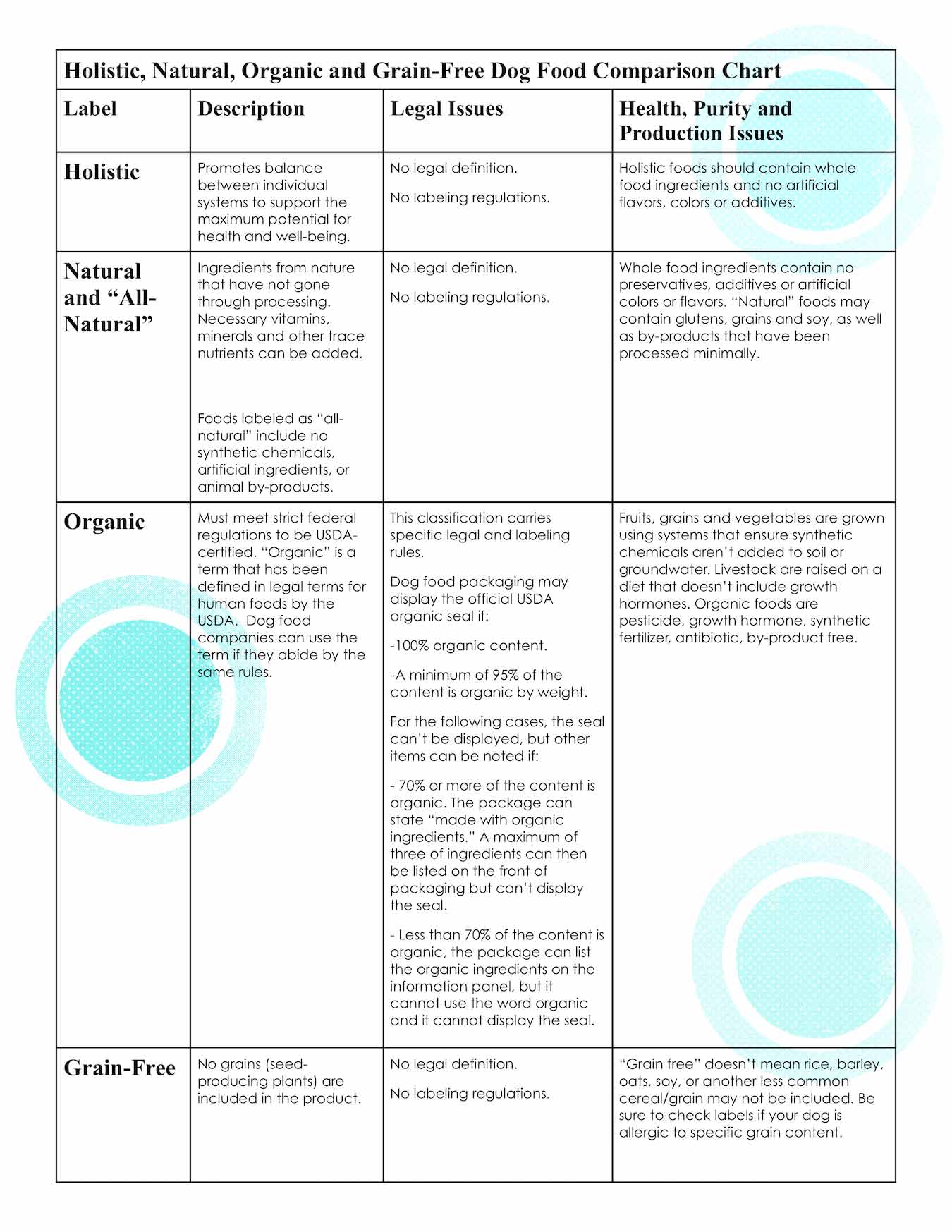
The Benefits of Holistic Dog Food
“Natural holistic pet food is better for the canine companion. As Hippocrates, the father of medicine says, Let Food Be Thy Medicine, and I agree,” says Dr. Dym. “Processed and toxic pet foods are one of the top three major factors in the epidemic of chronic disease and cancer seen in pets today, and feeding wholesome food is the single most important decision a canine guardian can make toward a life of good health and longevity.”
Here is a list of holistic food benefits:
- Digestibility: A dog that is fed holistic food tends to have much better intestinal health because these foods frequently contain probiotics. These types of ingredients are formulated to help healthy bacteria flourish in your dog’s intestines which aids in healthy digestion. Many highly-processed dog foods are difficult to digest and cause irritation to the GI tract. Senior pets who are suffering from the cumulative effects of years of poor nutrition often benefit from more easily absorbed food.
- Increased Energy: In a higher-quality food, the nutrients are more readily available for use. When a dog eats poor quality food, the body expends more energy to break down and access nutrients. She has less energy to play, be an enthusiastic companion, perform tasks, and/or train.
- Skin Health: Dry, flaky skin and a dull coat are reflections of the state of your dog’s overall health and nutritional status. Ear infections can be a chronic problem and are closely linked to diet. Treatment with topical and oral medicines for extended periods of time may not resolve the issue, but a grain-free, wholesome diet can drastically improve the condition.
- Eye Health: Antioxidant-rich ingredients are good for your dog’s overall health and also support eye health. As dogs age, many will experience eyesight issues, and some breeds have a tendency towards eye trouble. A holistic dog food diet can help to mitigate these concerns.
- Heart Health: Holistic dog foods are usually less fatty than standard brands, which means your dog will be leaner and have fewer of the weight issues that affect heart function.
- Bowel Health: The fillers in lower quality food contribute to more frequent bowel movements. Making the switch to a grain-free holistic diet can reduce the need for ‘potty breaks’ to just once or twice a day. Plus, improved digestibility supports your dog’s colon health.
- Healthier/Shinier Coat: A dog who is getting the right nutrition with healthy digestion will have a shiny coat and will shed less. An ingredient that supports coat health is fish oil, which is why many holistic foods use fish oil supplements.
- Fewer Allergies: Most dogs with allergies thrive on holistic foods, usually because the cause—grain sensitivity—has been removed. Look for holistic food rich in vitamin E and fish oil.
- Longevity: When your pet is well fed with holistic, natural food and has a healthier heart, better digestion and bowel health you can help extend your buddy’s life.
Choosing a food with nutritious, all-natural ingredients can help ensure your pet stays healthy and happy for years to come.
Comparing ‘Holistic’ Dog Food Brands
“I stress to my clients to look for foods whose ingredient list includes at least two out of three of the first ingredients listed as either whole meat or meat meals, and NOT meat by-products or processed parts of indigestible grains,” explains Dr. Dym. “The food should be made with fresh, wholesome ingredients, free of artificial preservatives, dyes, and colorings, including BHA, BHT, etc. It should be naturally preserved with tocopherols and vitamin C. The longevity (meaning how long the product has been in the marketplace) of the pet food, as well as holistic veterinarian experiences, relationships or veterinary testimonials, can help consumers assess a brand’s trustworthiness.”
Dr. Margolin adds, “Dog food that includes simple ingredients are best. However, products with multiple sources of proteins can cause a sensitivity, especially with chicken. It’s important to check the ingredients in the dog food you’re purchasing to make sure mass-produced poultry isn’t part of the blend.”
When you’re shopping for the best, most wholesome food for your dog, consult with your veterinarian and look for the ingredients that will support your dog’s good health. To make selecting a holistic dog food more straightforward, here’s a comparison chart of the foremost holistic dog food brands:
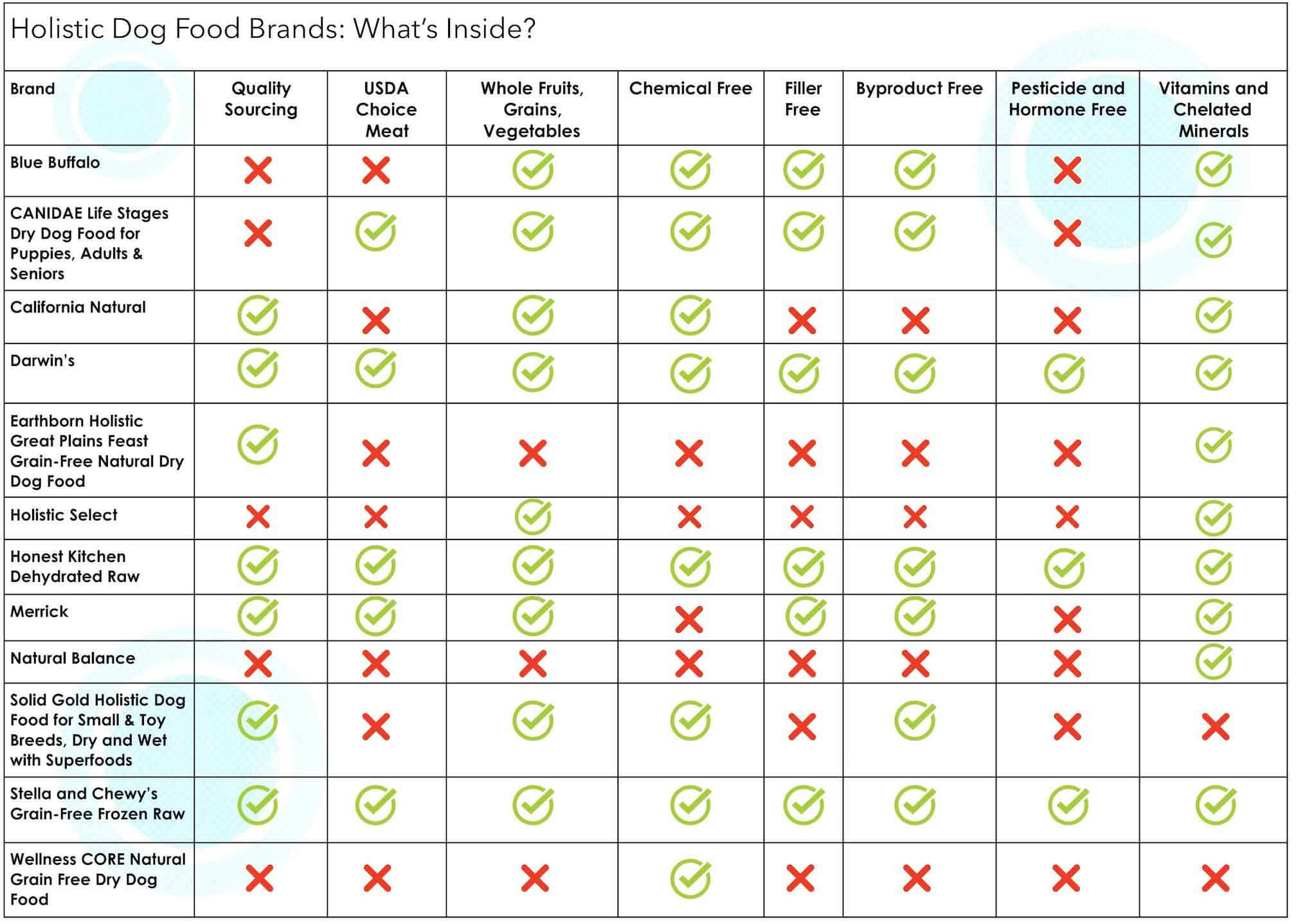
Darwin’s and the Power of Feeding Holistic Dog Food for Achieving Optimum Health
Recent nutritional science increasingly supports an ancestral diet—high protein, balanced fats, and at least some fresh foods—as the healthiest approach to feeding most dogs. You can count on Darwin’s raw food to be holistic, natural, free of hormones, steroids, and antibiotics. A key element of holistic dog food is sourcing ingredients from a known source. We visit every farm that raises the animals we use in our meals to make sure they employ good farming practices and treat both their animals and employees with respect.
At Darwin’s Pet Products, our number one goal is to help keep your pets healthy and active for as long as possible. To help accomplish this goal, we provide a library of articles in the hope of providing consumers with useful information to help their pets. And, primarily, we produce affordable, high-quality raw dog and cat meals which we ship directly to consumers so they are as fresh and convenient as possible. Our meals are high in protein, gluten-free, wheat-free, and are created to provide complete and balanced nutrition. We encourage you to learn more about our meals for dogs and meals for cats.
If you think you might want a trial of Darwin’s (at an introductory price), we would love to send you our meals and hear how much your dog or cat loves them.
Let’s Connect!
Darwin’s Pet Food Advisors are here for you and your dog. Learn more about the high-quality standards of our pet foods and how raw can benefit your dog.
Call a Pet Food Advisor at 877-738-6325 or email us.



